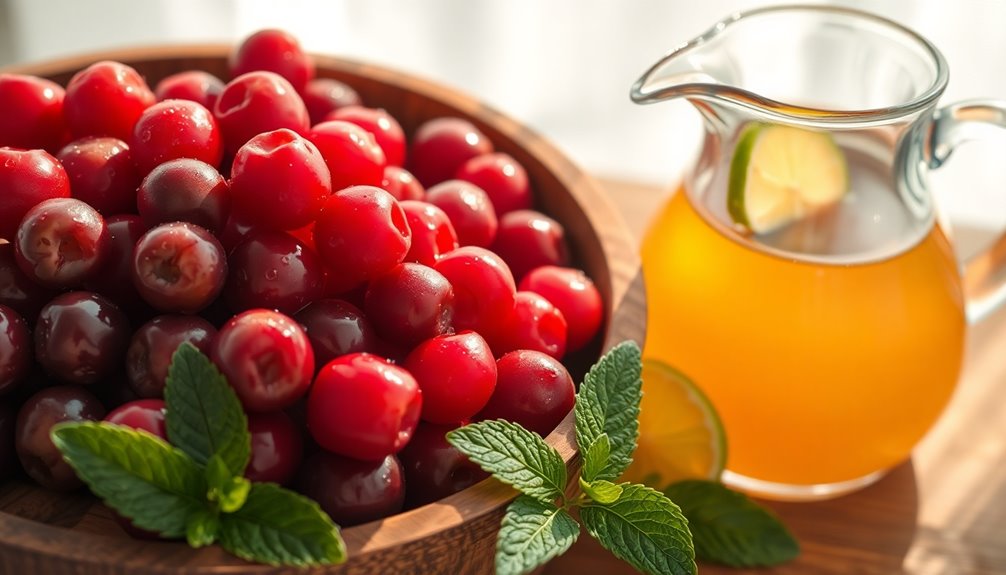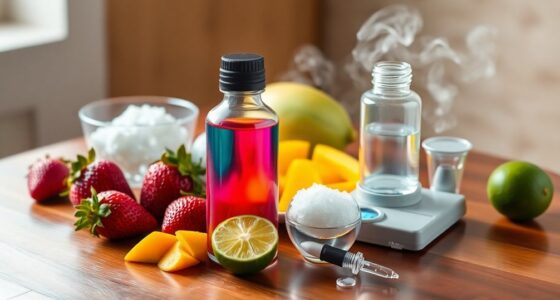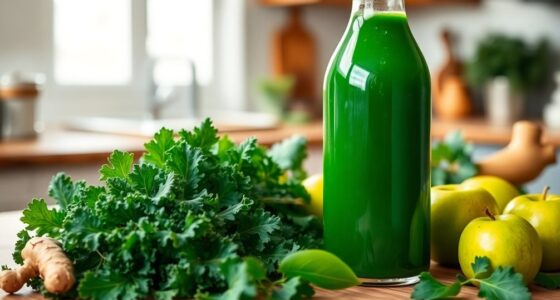To make cranberry juice less acidic, try diluting it with water or mixing in a splash of fresh citrus juice for a zesty twist. You can also sweeten the juice with honey or maple syrup, adjusting to your taste. Blending cranberries with sweeter fruits like apples or pears is another great option, creating a deliciously sweet juice while retaining that unique cranberry flavor. If you want more tips and tricks to enhance your drink, keep exploring! For those curious about how to enhance cranberry juice flavor, consider adding a touch of ginger for a spicy kick or incorporating herbs like mint for a refreshing note. Experimenting with spices such as cinnamon or nutmeg can also bring warmth and depth to your beverage. Don’t hesitate to mix and match these ideas to find your perfect combination, making your cranberry juice both enjoyable and uniquely yours!
Key Takeaways
- Use electrodialysis to deacidify cranberry juice, reducing acidity by up to 80% for a smoother flavor profile.
- Dilute cranberry juice with water or mix in fresh citrus juice to lower perceived acidity while enhancing taste.
- Sweeten with honey or maple syrup to mask acidity without reducing it, creating a balanced flavor.
- Blend cranberry juice with sweeter fruits like apples or pears to reduce acidity and add extra health benefits.
- Experiment with different ratios of cranberries to other fruits to achieve a more enjoyable and less acidic juice.

Cranberry juice is known for its vibrant flavor, but its high acidity can be a turn-off for many. If you find the tartness overwhelming, you're not alone. Many people prefer a less acidic version that still retains the juice's health benefits. Fortunately, there are several effective methods to achieve this, especially if you're looking to enhance your cranberry juice consumption without compromising on taste or nutrition.
One innovative solution is electrodialysis, a process that can deacidify cranberry juice by up to 80% within just six hours. Using the ED2MB configuration, this method selectively removes organic acids like citric, malic, and quinic acids, which are primarily responsible for the tartness you might find off-putting. The migration rates for these acids vary, meaning that the process is efficient and can be tailored to achieve the level of acidity that suits your palate.
As a result, you can enjoy a juice that offers a more balanced flavor profile, allowing the natural sweetness to shine through without the overwhelming tang.
If you're not ready to invest in electrodialysis, there are simpler methods you can try at home. For instance, diluting cranberry juice with water or other juices can effectively lower the perceived acidity. Mixing in a splash of fresh citrus juice can add a zesty twist while making the drink taste less acidic. You'll still get that fresh flavor, but with a much more enjoyable and smooth experience.
This method is easy to scale, so whether you're making a single glass or a larger batch, it's a practical solution for anyone looking to adjust their drink.
Another option is to sweeten your juice naturally. Although traditional sweeteners like honey or maple syrup can mask the acidity, they won't necessarily reduce the acid content itself. However, they can help you achieve a sweet flavor that complements the tartness. This balance can make your drink more enjoyable and improve your overall experience.
Just remember to start with a small amount, then adjust to taste, so you don't overwhelm the juice's natural flavor.
Additionally, if you're keen on crafting your own cranberry juice, consider experimenting with the ratios of cranberries to other fruits. By blending cranberries with sweeter fruits like apples or pears, you can create a deliciously sweet juice that still retains the unique cranberry flavor but is significantly less acidic.
This method not only adds a delightful sweetness but also introduces additional health benefits from the other fruits.
Making cranberry juice less acidic doesn't have to be a challenge. With the right techniques, whether through electrodialysis or simple home adjustments, you can enjoy a drink that's both flavorful and easier on your taste buds.
With a little experimentation, you'll find the perfect blend that meets your preferences, allowing you to savor the health benefits and delicious taste of cranberry juice without the overpowering acidity.
Frequently Asked Questions
How Do You Make Cranberries Less Acidic?
To make cranberries less acidic, you can try several methods.
First, consider diluting them with water or mixing them with sweeter fruits to balance the tartness.
Adding natural sweeteners like honey or maple syrup can also help mask the acidity.
If you chill the cranberries before eating them, their sourness might become less pronounced.
Each of these options allows you to enjoy cranberries while reducing their sharp taste effectively.
Is It Okay to Dilute Cranberry Juice With Water?
Yes, it's perfectly okay to dilute cranberry juice with water.
You'll find that mixing equal parts juice and water can significantly soften its tartness while still preserving its health benefits.
You can also chill the mixture for a refreshing taste, or serve it over ice for gradual dilution.
Experiment with different ratios to discover your perfect balance.
Enjoy your drink as it becomes more palatable and tailored to your personal preferences!
What Can You Mix Cranberry Juice With?
You can mix cranberry juice with a variety of ingredients to enhance its flavor.
Try combining it with water for a lighter taste, or add natural sweeteners like honey or maple syrup to balance its tartness.
Mixing in other fruit juices, such as apple or orange, can introduce sweetness and complexity.
For a refreshing twist, infuse cranberry juice with fresh mint or citrus slices.
Serving it over ice is another great option!
Why Does My Cranberry Juice Taste Acidic?
Your cranberry juice tastes acidic because it contains high levels of organic acids, mainly citric, malic, and quinic acids.
These acids give the juice its tart flavor, which can be quite overwhelming. If you're drinking pure, unsweetened cranberry juice, the bitterness and acidity will stand out even more, making it less enjoyable.
This natural tartness can be off-putting, especially if you're not accustomed to such strong flavors.
Conclusion
By following these simple tips, you can enjoy cranberry juice without the harsh acidity. Whether you choose to dilute it with water, add sweeteners, or mix it with other juices, there's a way to suit your taste. After all, isn't it worth exploring different flavors to find what brings you joy? Embrace the versatility of cranberry juice and create a drink that refreshes you while keeping that tartness in check. Cheers to a balanced sip!
Cindy thoroughly researches juicing trends, techniques, and recipes to provide readers with practical advice and inspiration. Her writing style is accessible, engaging, and designed to make complex concepts easy to understand. Cindy’s dedication to promoting the advantages of juicing shines through her work, empowering readers to make positive changes in their lives through the simple act of juicing.











